
by Sheila Dunning | May 17, 2019

Natural bark mulch
There have been a lot of questions about the use of colored mulches in the landscapes. Many individuals are concerned about the possibility of negative environmental impact from the dyes used on wood chips and pine straw. According to the Center for Agriculture, Food and the Environment (https://ag.umass.edu) the primary concern with colored landscape mulches is not the dyes used for coloring. Rather, it is about the sources of wood chips and the possibility of contamination with toxic substances.
The dyes used in coloring wood mulch are primarily of two types: carbon-based dyes and iron oxide based dyes. Iron oxide, the most commonly used dye, is simply a compound of iron and oxygen. As the compound oxidizes, iron is released to the soil but is not considered to be toxic. Dyes that are not absorbed by or adsorbed to the wood would come off with contact, especially if the mulch is wet. There are also some carbon-based dyes used on mulch. These carbon-based colorants are similar to those used in ink and cosmetics. Other dyes for mulch are vegetable-based and therefore organic. At this time, there is no evidence that the dyes used to color wood chip mulch are toxic.
Most of the wood used for making colored mulch comes from recycled wood, i.e. wood scraps, wood pallets, and wood reclaimed from construction and demolition (C&D) waste. Besides the benefits of recycling waste wood materials, the reason why these wood materials are used for colored mulches is that they are very dry and readily absorb or adsorb coloring agents.
Unfortunately, some of the recycled waste wood used for making landscape mulch products is contaminated with various chemicals, such as creosote and CCA (chromated copper arsenate). CCA is the chemical that was used in the manufacturing of pressure-treated wood.
Even though arsenic-based wood preservatives were banned in 2003, there are still plenty of CCA preserved wood being re-purposed. Sometimes wood pallets that have been used in the transport of chemical agents can become contaminated by spills of these chemicals. CCA and other toxic chemicals have been found to be contaminating soil where colored mulch made from these wood products have been applied. CCA treated wood can kill beneficial soil bacteria, beneficial insects, earthworms and young plants. It can also be harmful to people spreading this mulch and animals who dig in it.
Additionally, dyed mulches break down much slower than natural mulches. The greatest advantage to using them is to reduce the expense and time required to replenish the mulch. When wood breaks down, it requires nitrogen to do so. Colored mulch can actually rob the plants of the nitrogen they need to survive. Natural mulches retain moisture and add organic material back to the soil enabling the plants to better utilize nitrogen. Avoiding the use of colored mulches reduces the risk of contamination better than any other practices. Colored pine straw may be an alternative.
It should not be assumed that all colored mulches are contaminated. However, anyone planning to use colored mulch should become familiar with the supplier and the source of the wood used in making it. If C&D waste wood is used, it should be a red flag that there is a possibility of CCA contaminated mulch.

Certified Mulch Label
If you wish to improve the chances that the dyed mulch that you are buying is safe for humans to handle look for the MSC Certification Logo on the packaging. MSC stands for Mulch and Soil Council, whose responsibility is to certify that a mulch or soil product is free of CCA-treated wood. According to MSC’s Product Certification program, “Certified mulches and soils can be found at major retailers and garden centers across the country.” If you have concerns after contacting the supplier about the source of the wood used, contact a private environmental testing lab in your area.
While reading packaging, check the source of the product. If the supplier is a land management company rather than a processing mill it may be that mature trees are being removed and shredded. These mulches are sold as “long-lasting”, “no-float” products. They have the appearance of pine straw, but are actually finely shredded cypress from the heart of trees. These are coming from properties where the bald and white cypress trees are harvested for mulch. You can tell that it isn’t pine straw because the mulch pieces lack pine needle structures such as the fascicles and a revolute shape. While the use of these products is not contaminating, it is still depleting the environment. Mulches that are natural by-products are the most Eco-friendly.

by Sheila Dunning | Apr 9, 2019
 Call 811 before you dig. No one wants a weekend project to be the cause of Internet, phone and cable outages. Worse yet, what if someone gets hurt from contact with natural gas or electrical lines? That’s why it is so important to have buried utilities in the yard located and marked before digging. Sunshine 811 coordinates each individual company to clearly mark where the service lines are located. Homeowners are required by law to contact 811 three days before any soil removal is done. The service is free.
Call 811 before you dig. No one wants a weekend project to be the cause of Internet, phone and cable outages. Worse yet, what if someone gets hurt from contact with natural gas or electrical lines? That’s why it is so important to have buried utilities in the yard located and marked before digging. Sunshine 811 coordinates each individual company to clearly mark where the service lines are located. Homeowners are required by law to contact 811 three days before any soil removal is done. The service is free.
Have information prepared before making the request. Describe the work to be performed (e.g. fence install, landscaping, irrigation install), including the type of equipment that will be used. Specify the exact location on the property and how long the work will continue. Finally, provide all the contact information (e.g. name, phone number, e-mail), should there be any additional questions.
Call 811 or request a single address ticket online. Receive a ticket number and wait two full business days, not counting weekends or holidays. Then contact 811 again. Make sure that all the utilities have responded in the Positive Response System (PRS). Sometimes that may mean that the company doesn’t have anything to make in the area.
If there are utility lines running through the yard, they will be marked with specifically colored paints or flags. Red is used for electrical lines, orange indicates communication lines, yellow means gas, blue is used for potable water, purple is reclaimed water, and green indicates sewer lines. White lines may be used to outline digging areas and pink are temporary survey marks. This is the APWA Uniform Color Code.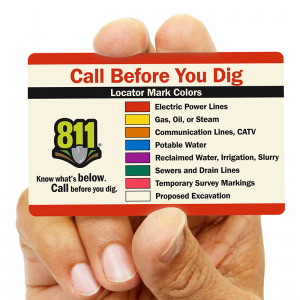
Every effort is made to locate the lines as accurately as possible. But, the safest thing to do is hand dig to expose the utility line before using any mechanized equipment. Lines can vary up to 24” from the marked line and depths can be less than 5”. Remember there may be access lines running through the property even if that service isn’t utilized at that address.
Keep safe this spring. Call 811 before digging.
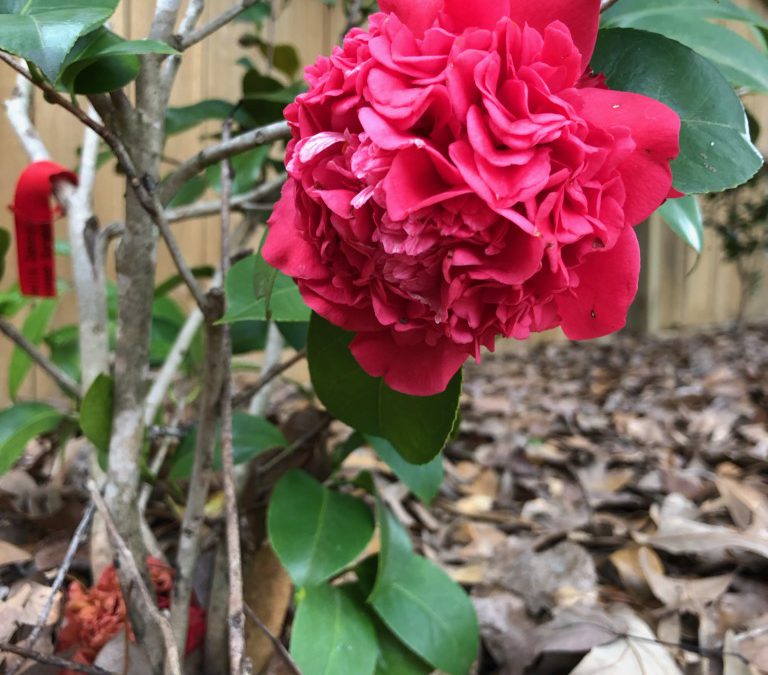
by Sheila Dunning | Jan 18, 2019

Camellia sasanqua ‘Kanjiro’ at the South Carolina Botanical Garden
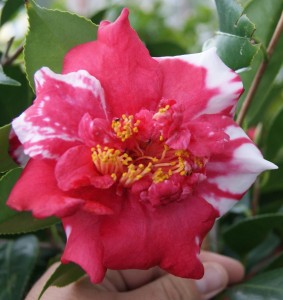
Bi-color Camellia varieties add character to the winter garden
Camellias have been a part of the landscape in the Southeastern United States for over 200 years. They are native to Asia and were introduced near Charleston, South Carolina in 1786. The common name camellia refers to varieties and hybrids of Camellia japonica and to lesser known varieties of C. sasanqua and C. reticulata. The growing conditions in Northwest Florida are well suited for many camellia varieties. Camellias can serve several functions in the landscape including foundation plantings, screens, accent plants, background groupings and hedges. Maximum benefit can be achieved by mass plantings or groupings. Single plants should be focal point in beds rather than randomly placed throughout the lawn. Camellias flower in the fall and winter when their display of colorful blooms is most appreciated. During the remainder of the year their evergreen foliage, interesting shapes and textures, and relatively slow growth make camellias excellent landscape plants. Some camellia growers enjoy competing in flower shows and manipulate the flower buds to achieve larger and earlier flowers. This involves removing competing flower buds and applying gibberellic acid (a plant hormone). Individual cultivars can be selected for size and form ranging from small and irregular to large and upright. Texture and foliage color also differ among the various species and multiple varieties. Midseason flowering varieties that bloom from November through January are best suited for Florida conditions. Warm fall temperatures may prevent early varieties from flowering properly.
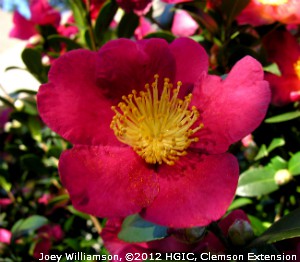
Camellia ‘Vernalis Yuletide’ at the South Carolina Botanical Garden
Late-blooming selections may attempt to send out new leaves before the end of the flowering period which results in “bullnoses”. Bullnosing is characterized by poor quality flowers which do not open fully and may even drop while still tight buds. Extended dry periods while in the bud stage can make the condition more likely. While flowering, camellias need 1 inch of water applied each week. Camellias perform best in partially shaded locations which are enhanced by good drainage and air movement. Fertile, acidic soils high in organic matter are preferred. The soil must be well drained because camellias will not grow in wet areas. Do not plant them in areas with a high water table and/or hard pan. This will result in a shallow root system which is more susceptible to injury during dry periods. Camellias should be installed where cold air can move in and out freely, but the area should be protected from strong northwest winds. Plantings under established trees or in areas that has structures to block the wind are usually injured less by cold temperatures. These conditions enable the plants to gradually thaw or warm in the morning before being exposed to direct sunlight. Dense shade may result in sparse foliage and poor flowering. Camellias exposed to full sun may appear yellow-green, but may yield more flowers. Either situation id stressful to the plants and can lead to pest problems. Tea scale is the most common insect on camellias. Scales generally feed on the underside of leaves and may not be noticed until large populations have developed. Symptoms include very small elongated white and/or brown raised “flakes” on the underside of leaves that turning yellowish in color.

by Sheila Dunning | Dec 17, 2018
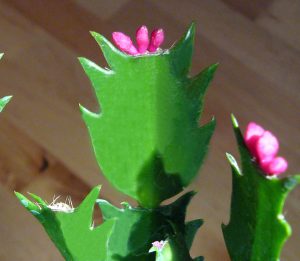
University of Minnesota Extension
Julie Weisenhorn
Is your grandmother’s pass along Christmas cactus blooming really early? Do the leaf segments have “teeth” along the edges? Are the “stringy things” sticking out of the flowers yellow in color? Well, I hate to tell you this, but that is not a Christmas cactus, (Schlumbergera bridgesii). It is a Thanksgiving cactus, (Schlumbergera truncata). You can tell the Thanksgiving cactus apart from the Christmas cactus by the shape of the leaves and flower anthers. The leaves, botanically referred to as phylloclades, are serrated on the Thanksgiving cactus. Additionally, the pollen-bearing anthers in Thanksgiving cactus flowers are yellow. Christmas cactus have smooth-edged leaves and pinkish-purple anthers. Both of these species are native to the coastal mountains of south-eastern Brazil, where they are found growing in trees or on rocks. Therefore, the preferred potting media for Thanksgiving and Christmas cacti should contain about 40% perlite to ensure good drainage and aeration. To care for your Thanksgiving cactus, allow the soil to dry out when it is not blooming. As flower buds develop, the soil should be moist to the touch. However, overwatering can kill the plant. Additionally, provide plenty of indirect light and temperatures of 60-65 degrees F. Want to get last year’s plant to bloom again? Beginning in mid-September, it will need 12-14 hours of total darkness along with cool (60-65 degrees F) nighttime temperatures for 3-4 weeks. To achieve the light control the cactus can be placed in a closet or covered with a large brown paper bag overnight. Once buds start to form, fertilizer can be applied to encourage growth and blooms. However, flower buds will fall off with any significant changes in temperature (below 50 degrees F), light or watering.
Now, if your “Christmas cactus” doesn’t set flowers until spring, it is probably an Easter cactus, a totally different species (Rhipsalidopsis gaetner). The leaf margins of Easter cactus have small bristles and are more three-dimensional with a thick ridge on one side. Additionally, the flower are more star-shaped than the other two cacti. All three cacti species have flowers that come in a range of colors including variations of red, pink, peach, purple, orange or white.
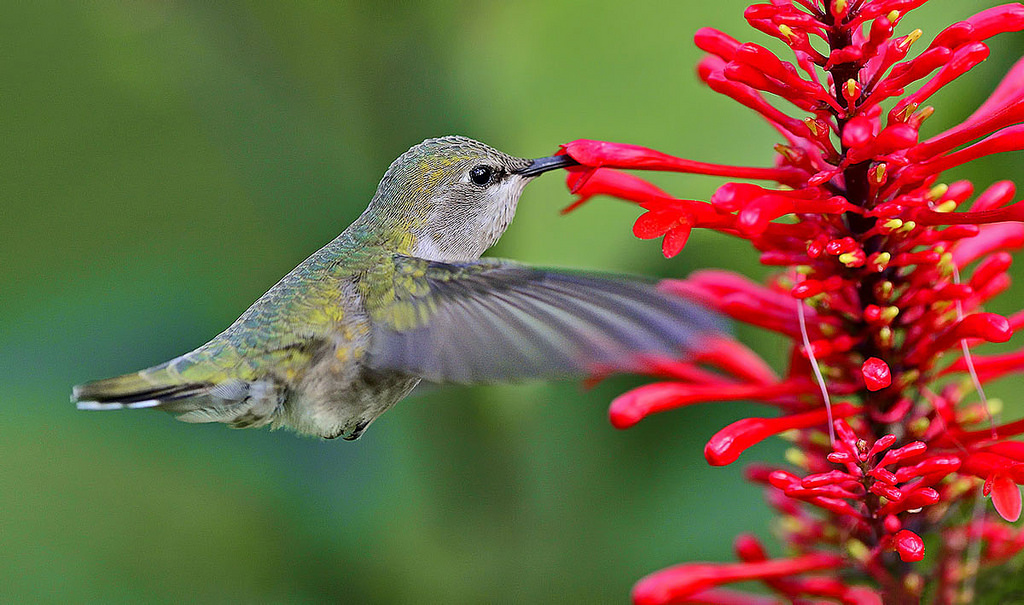
by Sheila Dunning | Nov 8, 2018
 Looking to add something to brighten your landscape this autumn? Firespike (Odontonema strictum) is a prolific fall bloomer with red tubular flowers that are very popular with hummingbirds and butterflies. It’s glossy dark green leaves make an attractive large plant that will grow quite well in dense shade to partial sunlight. In frost-free areas firespike grows as an evergreen semi-woody shrub, spreads by underground sprouts and enlarging to form a thicket. In zones 8 and 9 it usually dies back to the ground in winter and resprouts in spring, producing strikingly beautiful 9-12 inch panicles of crimson flowers beginning at the end of summer and lasting into the winter each year. Firespike is native to open, semi-forested areas of Central America. It has escaped cultivation and become established in disturbed hammocks throughout peninsular Florida, but hasn’t presented an invasive problem. Here in the P
Looking to add something to brighten your landscape this autumn? Firespike (Odontonema strictum) is a prolific fall bloomer with red tubular flowers that are very popular with hummingbirds and butterflies. It’s glossy dark green leaves make an attractive large plant that will grow quite well in dense shade to partial sunlight. In frost-free areas firespike grows as an evergreen semi-woody shrub, spreads by underground sprouts and enlarging to form a thicket. In zones 8 and 9 it usually dies back to the ground in winter and resprouts in spring, producing strikingly beautiful 9-12 inch panicles of crimson flowers beginning at the end of summer and lasting into the winter each year. Firespike is native to open, semi-forested areas of Central America. It has escaped cultivation and become established in disturbed hammocks throughout peninsular Florida, but hasn’t presented an invasive problem. Here in the P anhandle, firespike will remain a tender perennial for most locations. It can be grown on a wide range of moderately fertile, sandy soils and is quite drought tolerant. Firespike may be best utilized in the landscape in a mass planting. Plants can be spaced about 2 feet apart to fill in the area quickly. It is one of only a few flowering plants that give good, red color in a partially shaded site. The lovely flowers make firespike an excellent candidate for the cutting garden and is a “must-have” for southern butterfly and hummingbird gardens. Additional plants can be propagated from firespike by division or cuttings. However, white-tailed deer love firespike too, and will eat the leaves, so be prepared to fence it off from “Bambi”.
anhandle, firespike will remain a tender perennial for most locations. It can be grown on a wide range of moderately fertile, sandy soils and is quite drought tolerant. Firespike may be best utilized in the landscape in a mass planting. Plants can be spaced about 2 feet apart to fill in the area quickly. It is one of only a few flowering plants that give good, red color in a partially shaded site. The lovely flowers make firespike an excellent candidate for the cutting garden and is a “must-have” for southern butterfly and hummingbird gardens. Additional plants can be propagated from firespike by division or cuttings. However, white-tailed deer love firespike too, and will eat the leaves, so be prepared to fence it off from “Bambi”.














